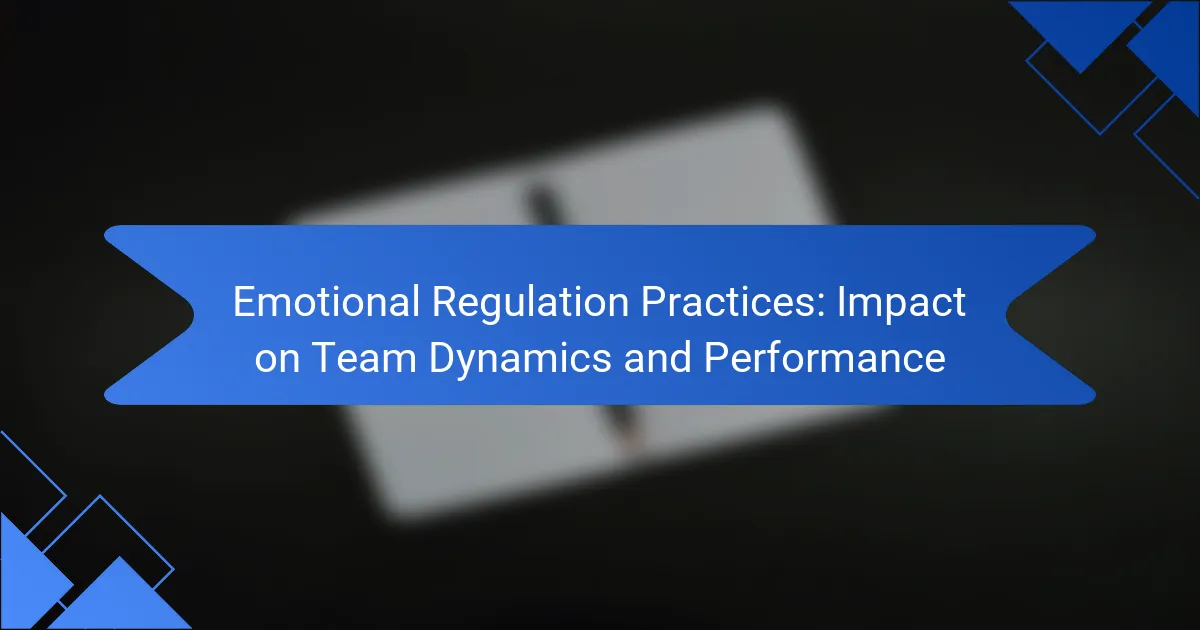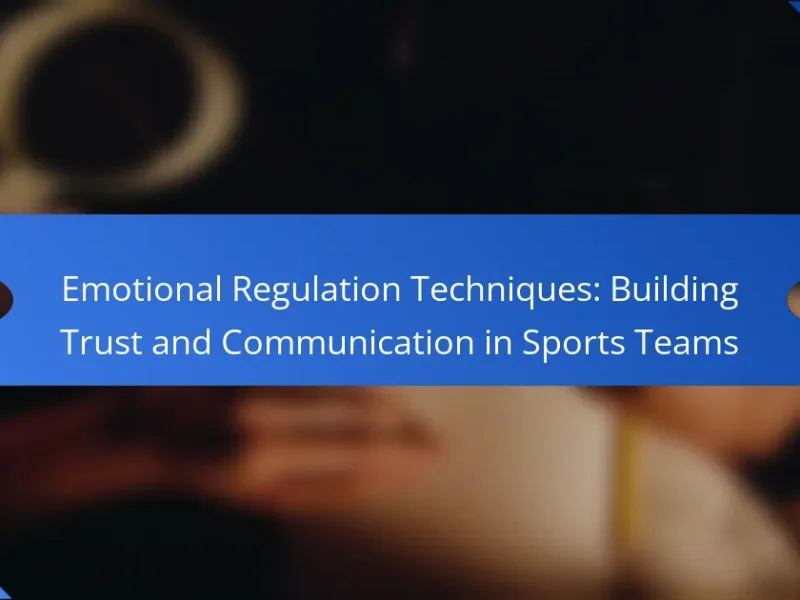Emotional regulation practices significantly enhance team dynamics and performance. They foster positive interactions, reduce conflict, and improve collaboration through mindfulness, cognitive restructuring, and emotional expression. These structured approaches promote empathy, open communication, and regular feedback. Ultimately, implementing these practices leads to increased productivity and a cohesive work environment.
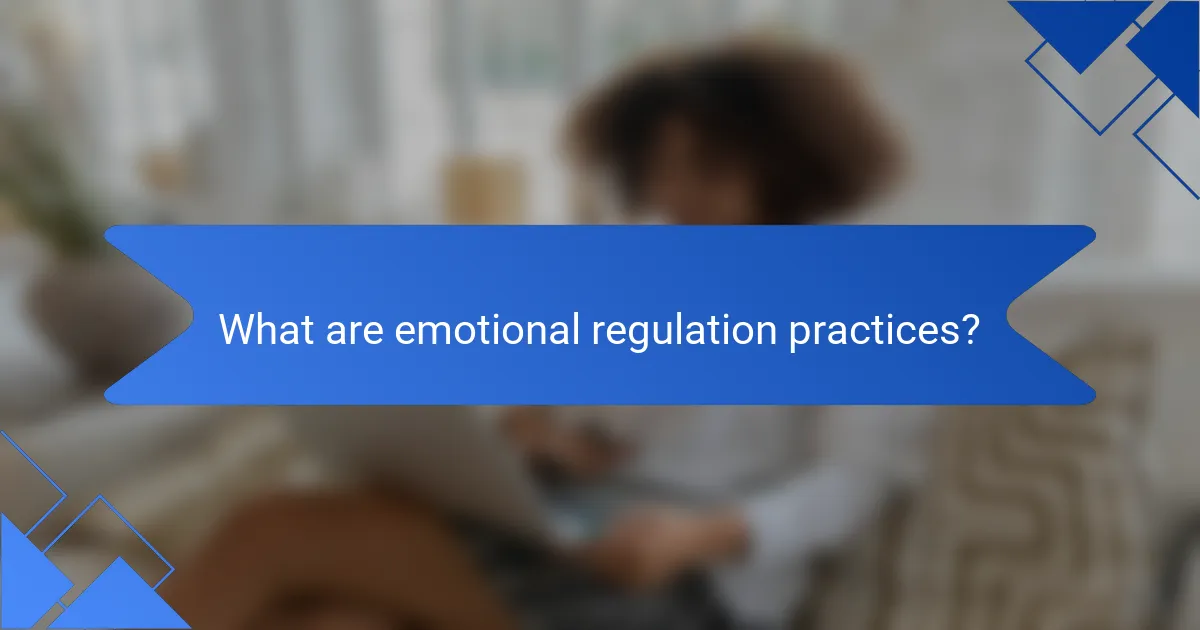
What are emotional regulation practices?
Emotional regulation practices enhance team dynamics and performance by fostering positive interactions and reducing conflict. These practices include mindfulness, cognitive restructuring, and emotional expression. Mindfulness helps individuals stay present, improving focus and collaboration. Cognitive restructuring encourages reframing negative thoughts, leading to better problem-solving. Emotional expression promotes open communication, strengthening trust among team members. Implementing these practices can result in increased productivity and a more cohesive work environment.
How do emotional regulation practices influence team dynamics?
Emotional regulation practices significantly enhance team dynamics by fostering collaboration and reducing conflict. These practices improve emotional awareness and communication, leading to increased trust among team members. Effective emotional regulation can result in higher performance levels, as teams become more adaptive and resilient in facing challenges. Research shows that teams with strong emotional regulation skills experience less stress and greater job satisfaction, ultimately driving better outcomes.
What are the key components of emotional regulation?
Emotional regulation involves managing and responding to emotional experiences effectively. Key components include awareness of emotions, cognitive appraisal, and the use of coping strategies. Awareness allows individuals to recognize their emotional states, while cognitive appraisal helps in interpreting these emotions. Coping strategies, such as reappraisal or suppression, directly influence team dynamics and performance by enhancing collaboration and reducing conflict. Implementing these practices fosters a supportive environment, leading to improved outcomes.
What are the benefits of emotional regulation in teams?
Emotional regulation in teams enhances collaboration, reduces conflict, and improves overall performance. Teams that practice emotional regulation experience increased trust and communication, fostering a positive work environment. This practice leads to better decision-making and innovation as members feel safe to express their ideas. Furthermore, teams with strong emotional regulation skills can adapt to challenges more effectively, maintaining productivity under stress.
How does emotional regulation enhance communication?
Emotional regulation enhances communication by fostering clarity and reducing misunderstandings. When team members manage their emotions effectively, they express ideas more clearly and listen actively. This practice builds trust, encourages collaboration, and improves overall team dynamics. As a result, teams experience increased performance and productivity, demonstrating the unique impact of emotional regulation on workplace interactions.
What impact does emotional regulation have on conflict resolution?
Emotional regulation significantly enhances conflict resolution by fostering understanding and collaboration among team members. It allows individuals to manage their emotions, reducing the likelihood of escalation during disputes. Effective emotional regulation practices create a supportive environment, leading to improved team dynamics and performance. Teams that practice emotional regulation experience increased empathy, which facilitates the identification of common goals and solutions. As a result, conflicts are resolved more efficiently, promoting overall team cohesion and productivity.
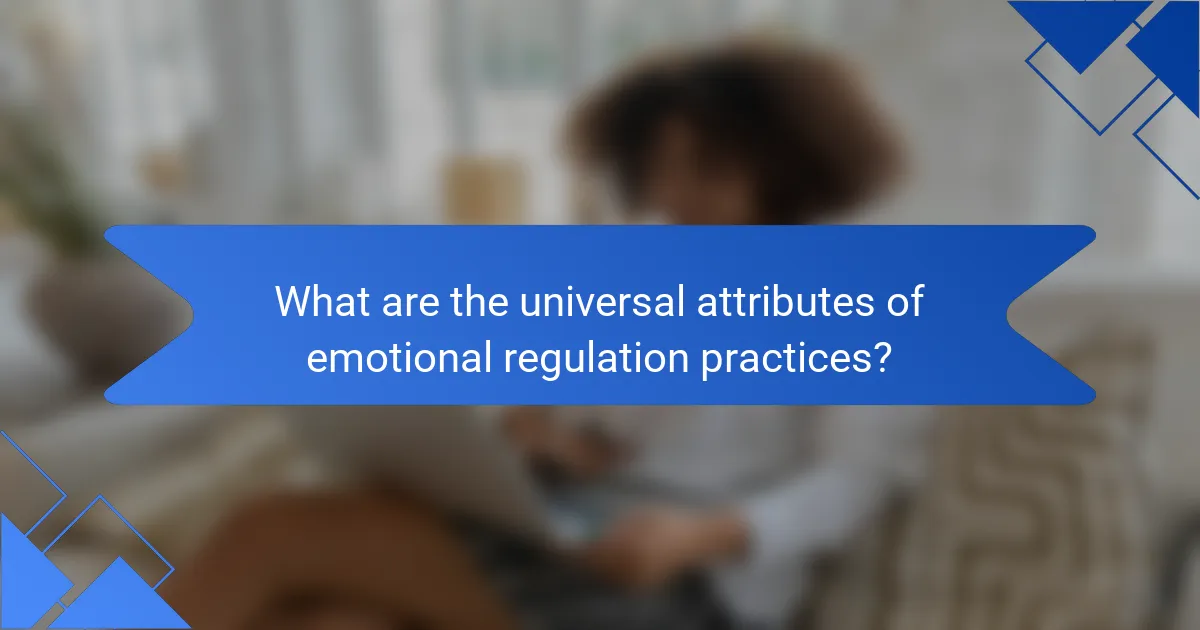
What are the universal attributes of emotional regulation practices?
Emotional regulation practices universally enhance well-being, communication, and conflict resolution. Key attributes include mindfulness, cognitive reappraisal, and emotional awareness. Mindfulness promotes present-moment focus, improving stress management. Cognitive reappraisal helps individuals reinterpret emotions, fostering resilience. Emotional awareness enables better understanding of feelings, enhancing interpersonal relationships. These practices ultimately lead to improved team dynamics and performance.
How do emotional regulation practices vary across cultures?
Emotional regulation practices vary significantly across cultures, influencing team dynamics and performance. Cultural norms shape how emotions are expressed and managed, affecting collaboration and conflict resolution.
For example, collectivist cultures may emphasize emotional restraint and group harmony, leading to indirect communication styles. In contrast, individualist cultures often encourage open expression of emotions, fostering direct feedback.
Research indicates that culturally informed emotional regulation strategies can enhance team cohesion and effectiveness. Understanding these differences is crucial for global teams to navigate emotional dynamics successfully.
By recognizing the unique attributes of emotional regulation in diverse cultures, teams can adapt their approaches to improve performance and collaboration.
What are some common techniques for emotional regulation?
Common techniques for emotional regulation include mindfulness, cognitive reappraisal, and deep breathing exercises. These practices enhance team dynamics and performance by fostering emotional awareness and resilience. Mindfulness helps individuals stay present, reducing stress and improving focus. Cognitive reappraisal encourages reframing negative thoughts, leading to a more positive outlook. Deep breathing exercises promote relaxation, enabling better decision-making and collaboration within teams. Implementing these techniques can significantly improve interpersonal relationships and overall team effectiveness.
How effective is cognitive restructuring in emotional regulation?
Cognitive restructuring is highly effective in emotional regulation, enhancing team dynamics and performance. This practice helps individuals identify and challenge negative thought patterns, leading to improved emotional responses. Research indicates that teams employing cognitive restructuring experience reduced conflict and increased collaboration. For instance, a study found that teams using these techniques reported a 30% increase in overall satisfaction and productivity. Additionally, cognitive restructuring fosters resilience, enabling team members to adapt to challenges more effectively.
What role does self-awareness play in emotional regulation?
Self-awareness significantly enhances emotional regulation by enabling individuals to recognize and understand their emotions. This understanding fosters better responses to emotional triggers, leading to improved team dynamics and performance. When team members are self-aware, they can manage stress and communicate effectively, reducing conflicts and enhancing collaboration. Research indicates that self-awareness is a key factor in emotional intelligence, which directly correlates with team effectiveness. Teams with high emotional intelligence demonstrate greater resilience and adaptability, contributing to overall success.

What unique attributes differentiate emotional regulation practices?
Unique attributes that differentiate emotional regulation practices include their adaptability to various contexts, the incorporation of individual emotional intelligence levels, and the specific techniques employed, such as mindfulness or cognitive restructuring. These attributes influence how effectively teams navigate emotional challenges, ultimately impacting performance and collaboration.
How do individual personalities affect emotional regulation strategies?
Individual personalities significantly influence emotional regulation strategies, affecting team dynamics and performance. For instance, extroverted individuals may employ more expressive strategies, fostering open communication. In contrast, introverted members might favor reflective approaches, leading to quieter but thoughtful contributions. These differences can create a balance within teams, enhancing overall emotional intelligence. A diverse mix of personalities allows for varied emotional responses, improving adaptability in challenging situations. Understanding these dynamics can optimize team performance and collaboration.
What is the relationship between emotional intelligence and emotional regulation?
Emotional intelligence enhances emotional regulation, leading to improved team dynamics and performance. High emotional intelligence allows individuals to recognize and manage their emotions effectively, which fosters better communication and collaboration. Teams with members skilled in emotional regulation often experience reduced conflict and increased resilience. This capability supports a positive work environment, enabling teams to adapt to challenges and maintain productivity.
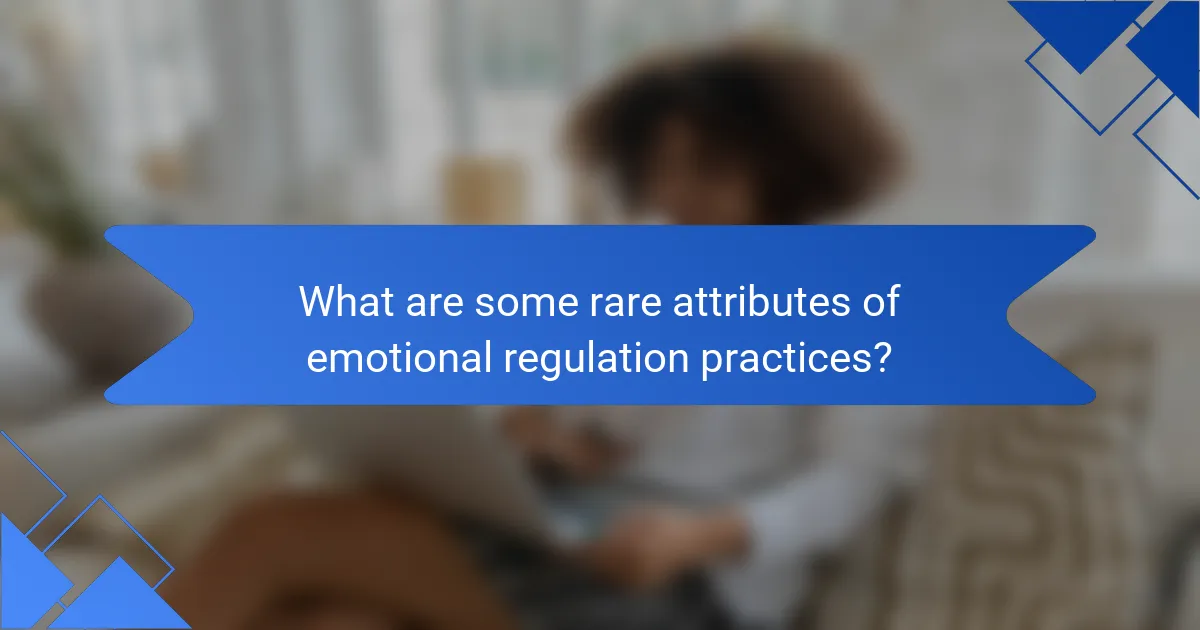
What are some rare attributes of emotional regulation practices?
Some rare attributes of emotional regulation practices include their ability to enhance creativity, facilitate deep empathy, and improve conflict resolution skills. These practices can lead to unique team dynamics that foster innovation and collaboration. Additionally, they may promote resilience in the face of adversity, allowing teams to adapt effectively to challenges.
How can emotional regulation practices be adapted for remote teams?
Emotional regulation practices can be effectively adapted for remote teams by implementing structured communication and regular check-ins. These practices enhance team dynamics and performance by fostering emotional awareness and resilience.
First, establish a virtual environment that encourages open dialogue. Regular video calls can promote face-to-face interactions, helping team members express emotions more authentically. For example, incorporating icebreaker activities can build rapport and trust among team members.
Second, utilize digital tools that facilitate emotional check-ins. Platforms like Slack or Microsoft Teams can host channels dedicated to sharing feelings or experiences. This practice not only normalizes emotional expression but also strengthens team cohesion.
Third, provide training on emotional intelligence and regulation strategies. Workshops or online courses can equip team members with skills to manage stress and navigate conflicts effectively. As a result, teams become more adaptable and productive.
Lastly, encourage a culture of feedback. Regularly soliciting input on team dynamics helps identify emotional challenges early. This proactive approach can mitigate conflicts and enhance overall team performance.
What innovative emotional regulation strategies are emerging in 2025?
Innovative emotional regulation strategies emerging in 2025 focus on technology integration and team-based approaches. Virtual reality (VR) environments are being utilized to simulate high-stress situations, allowing teams to practice emotional responses collectively. This immersive experience fosters empathy and strengthens interpersonal bonds, enhancing overall team dynamics. Additionally, AI-driven platforms are providing personalized emotional support tools, helping individuals manage stress in real-time. These advancements not only improve emotional resilience but also boost team performance by creating a supportive work culture.
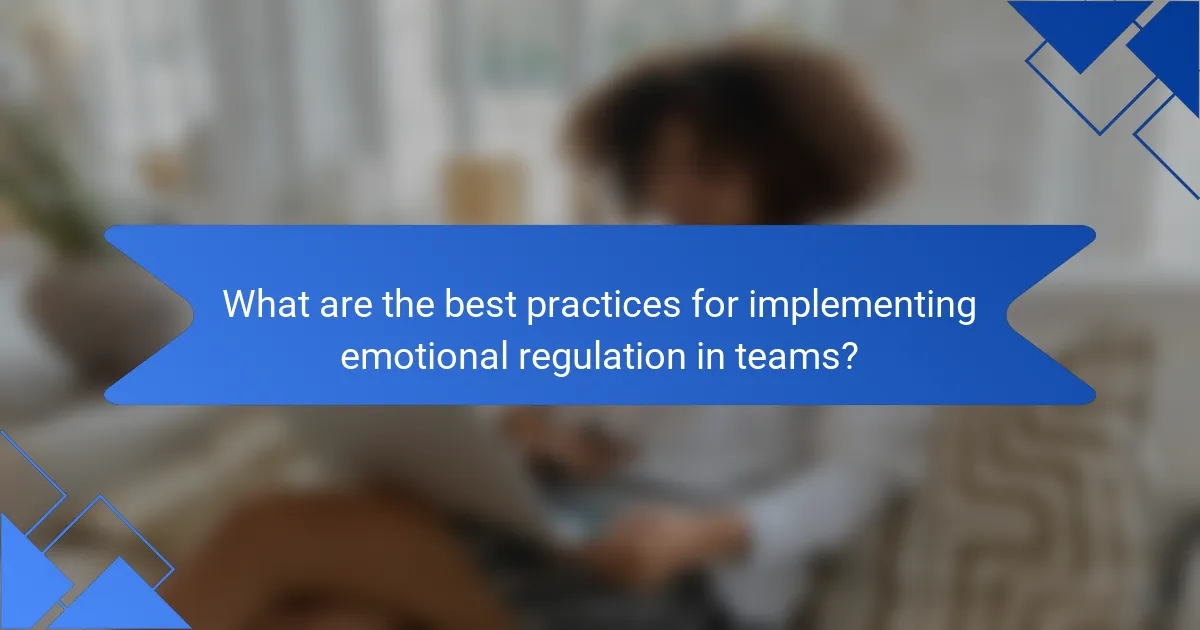
What are the best practices for implementing emotional regulation in teams?
Emotional regulation practices enhance team dynamics and performance through structured approaches. Key practices include fostering open communication, promoting empathy, and implementing regular feedback sessions. These methods encourage emotional awareness and resilience, leading to improved collaboration and productivity. For example, teams that engage in emotional check-ins report higher morale and reduced conflict. Additionally, training sessions focused on emotional intelligence can significantly boost team cohesion and effectiveness.
What common mistakes should teams avoid when adopting emotional regulation practices?
Teams should avoid common mistakes such as neglecting individual emotional needs, failing to provide adequate training, and overlooking the importance of consistent communication. Focusing solely on techniques without fostering a supportive environment can lead to ineffective practices. Additionally, not measuring the impact of emotional regulation on team dynamics can hinder progress and improvement.
How can leaders foster a culture of emotional regulation?
Leaders can foster a culture of emotional regulation by modeling behaviors and creating an environment that encourages open communication. Encouraging team members to express emotions can enhance trust and collaboration. Implementing training programs focused on emotional intelligence can lead to improved team dynamics. Regular check-ins and feedback sessions promote accountability and reinforce the importance of emotional awareness.
